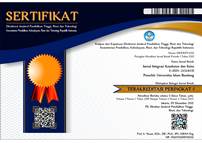Perilaku Orangtua Siswa Sekolah Dasar Sigaranten Sukabumi dalam Penanganan Infestasi Kutu Kepala
Abstract
Anak usia sekolah dasar masih banyak yang terinfestasi kutu kepala (Pediculosis capitis) saat ini. Infestasi kutu kepala ini menimbulkan rasa gatal yang dapat berkembang menjadi infeksi sekunder dan gangguan tidur, belajar, maupun sosial. Beragam upaya pengobatan dilakukan di masyarakat dan hingga saat ini belum ada pedoman tetap dalam menangani infestasi kutu kepala. Penelitian ini bertujuan menganalisis perilaku masyarakat dalam menangani infestasi kutu kepala dan hasil perilaku tersebut yang dilihat dari angka kejadian infestasi kutu kepala. Penyebaran kuesioner mengenai perilaku pengobatan infestasi kutu kepala pada masyarakat dilakukan pada 69 orangtua siswa kelas 5 Sekolah Dasar Negeri Sigaranten Sukabumi pada bulan Juni 2018. Kejadian infestasi kutu kepala pada siswa didapatkan dengan pemeriksaan rambut dan kulit kepala selama 5 menit setelah mendapat persetujuan orangtua siswa. Pada penelitian ini didapatkan 38 siswa yang terinfestasi kutu kepala (55%). Sebagian besar orangtua melakukan pengobatan infestasi kutu kepala pada anaknya dengan cara menyerit (64%). Tidak ada perbedaan bermakna perilaku penanganan infestasi dengan menyerit, menggunakan obat kutu, dan pengambilan kutu manual berupa kejadian infestasi kutu kepala pada siswa (p=0,054). Simpulan, perilaku pengobatan kutu kepala oleh orangtua pada anaknya sebagian besar belum efektif karena 55% siswa masih terinfestasi kutu kepala.
BEHAVIOR OF PARENTS OF SUKABUMI SAGARANTEN PRIMARY SCHOOL STUDENTS IN HANDLING HEAD LICE INFESTATION
There are still many primary school-age children who are infested with head lice (Pediculosis capitis). Head lice infestations cause itching which can develop into secondary infections and sleep, learning and social disorders. There are various efforts for treating head lice infestation in the community and until now there is no guideline treatment for head lice infestations. This study aims to analyze the behavior of people in treating the head lice infestations and the result as seen from the incidence of head lice infestations. The questionnaire regarding the behavior of head lice infestation treatment in the community was carried out on 69 parents of 5th grade students of Sigaranten Sukabumi Elementary School in June 2018. The incidence of head lice infestation in students was obtained by examining hair and scalp for 5 minutes after parents’ approval. In this study 38 students were infected with head lice (55%). The most parents treated head lice infestations by combing (64%). There were no significant differences in behavior of treating head lice by comb, pediculocid, and manual removal to the incidence of head lice infestation in students (p = 0.054). In conclusion, the behavior of head lice treatment by parents to their children is ineffective because 55% of students are still infested with head lice.
Keywords
Full Text:
PDFReferences
CDC. Head lice [internet]. Atlanta USA: CDC.2013. [diperbaharui 24 September 2013; diunduh 16 April 2019]. Tersedia dari: https://www.cdc.gov/ parasites/lice/head/epi.html.
Canyon DV, Canyon C, Milani S. Parental and child attitudes towards pediculosis are a major of reinfection. Open Dermatol J. 2014 April;8:24–8.
Zulinda A, Yolazenia, Zahtamal. Faktor-faktor yang mempengaruhi kejadian pedikulosis kapitis pada murid kelas II, IV, V dan VI SDN 019 Tebing Tinggi Okura Kecamatan Rumani Pesisir Pekanbaru. JIK. 2010 Mar;4(1):65–9.
Hardiyanti NI, Kurniawan B, Mutiara H, Suwandi JF. Penatalaksanaan pedikulosis kapitis. Majority. 2015 Des;4(9):47–52.
Canyon DV, Canyon C, Milani S. Characterizing the nature of human carriers of head lice. Open Dermatol J. 2014;8:29–31.
Allam NA, AL Megrin WA, Alkeridis LA. Abdellah F model to banishing social stigma of head lice among school students. Sci J Clin Med. 2016 Feb;5(1):1–11.
Tohit NFM, Rumpal L, Mun-Sann L. Prevalence and predictors of pediculosis capitis among primary school children in Hulu Langat, Selangor. Selangor Med J Malaysia. 2017 Feb;72(1):12–7.
Rassami W, Soonwera M. Epidemiology of pediculosis capitis among school children in the eastern area of Bangkok, Thailand. Asian Pasific J Trop Biomed. 2012 Nov;2(11):901–4.
Samsiah N, Astuti RDI, Rathomi HS. Hubungan derajat infestasi dan gejala gatal terhadap perilaku pengobatan Pediculosis capitis pada murid kelas I SDN Pelesiran Kota Bandung. Prosiding Pendidikan Dokter Spesia Unisba. 2017 Agustus;3(2):53–60.
Mumcuoglu KY, Gilead l, Ingber A. New insight pediculosis and scabies. Expert Rev Dermatol. 2009 Jun;4(3):285–302.
Madke B, Khopkar U. Pediculosis capitis: an update. Indian J Dermatol Venerol Leprol. 2012 Jul;78(4):429–38.
Madeira NG, de Souza PAT, Diniz RES. Perception and action of teachers and head lice in school. Revista Electronica Ensenanza de las Ciencias. 2015;14(2):119–30.
Stichele RHV, Gysssels L, Bracke C, Meersschaut F, Blokland I, Wittouck E, dkk. Wet combing for head lice: feasibility in masscreening, treatment preference and outcome. J Royal Soc Med. 2002 Jul;95:348–52.
Sangare AK, Doumbo OK, Raoult D. Management and treatment of human lice. Biomed Res Int. 2016. DOI 10.1155/2016/8962685.
Verma P, Namdeo C. Treatment of pediculosis capitis. Indian J Dermatol [internet]. 2015 MayJun;60(3):238–247. [diunduh 2 Okt 2018] Tersedia dari: doi 10.4103/0019-5154.156339.
DOI: https://doi.org/10.29313/jiks.v1i2.4692
Refbacks
- There are currently no refbacks.
Jurnal Integrasi Kesehatan dan Sains is licensed under a Creative Commons Attribution-NonCommercial-ShareAlike 4.0 International License.







.png)
_(1).png)





















